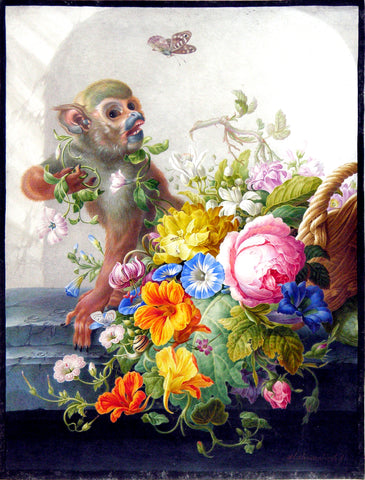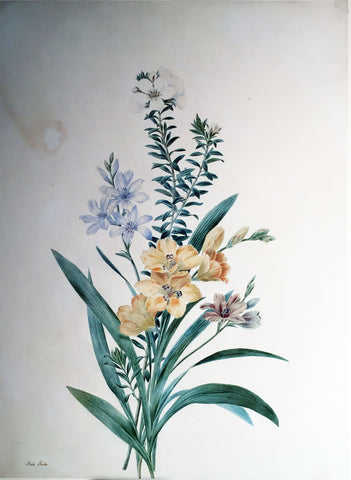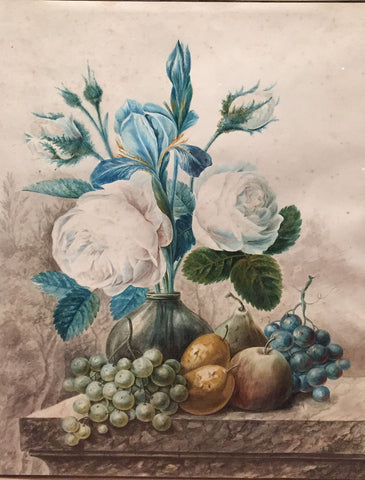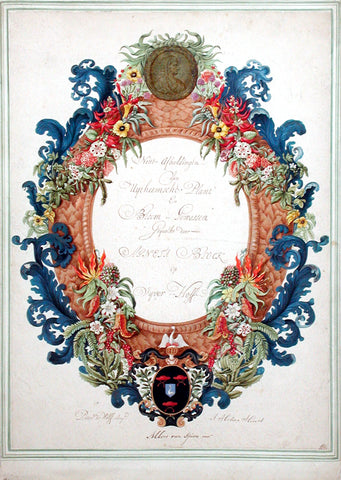
Herman Henstenburgh (DUTCH, 1667-1726) Still-life with a monkey and a basket of flowers on a stone ledge
Herman Henstenburgh (DUTCH, 1667-1726)
Still-life with a monkey and a basket of flowers on a stone ledge
Watercolor and gouache within black framing lines, on vellum
Paper size: 16 1/2 x 12 3/4 in
Frame size: 25 1/2 x 21 7/8 in
Signed l. r.: H. Henstenburgh. fec=
Provenance: Pieter van den Brande and/or Johan Pieter van den Brande, Middelburg; by descent to E. C. Baron van Pallandt; sold by him, Amsterdam, Mak van Waay, 26 September 1972, lot 336; private collection.
Still-life with a monkey and a basket of flowers on a stone ledge
Watercolor and gouache within black framing lines, on vellum
Paper size: 16 1/2 x 12 3/4 in
Frame size: 25 1/2 x 21 7/8 in
Signed l. r.: H. Henstenburgh. fec=
Provenance: Pieter van den Brande and/or Johan Pieter van den Brande, Middelburg; by descent to E. C. Baron van Pallandt; sold by him, Amsterdam, Mak van Waay, 26 September 1972, lot 336; private collection.
The development of natural history painting paralleled progress in the field of science. Drawing played an essential role in the advancement of natural history, and the influence of animal and plant illustration directly affected the development of allegorical and trompe l’œil painting.
The Dutch were at the forefront of these developments and managed to forge a remarkable synthesis between concern for scientific truth and natural history’s decorative and exotic aspects. Imaginative compositions joined flowers and birds with insects and reptiles to create fantastical juxtapositions imbued with symbolic meaning: snakes, lizards, and frogs were related to Medusa; butterflies were also associated with the story of Psyche and the theme of Vanities; the caterpillar corresponds to man, the chrysalis to death, and the butterfly to the soul after the resurrection.
Herman Henstenburgh produced exemplary examples of this genre. In his remarkable paintings, he creates a play of lines and colors that can be appreciated not merely for its decorative aspects but also as a departure from the naturalist’s strictly narrative view towards an art approaching abstraction. Henstenburgh was a pupil of Johannes Bronckhorst, a fellow native of Hoorn in the Netherlands. According to contemporary accounts, his early works imitated his master’s, depicting birds and landscapes. He later broadened his repertoire to include exquisite flower and fruit pieces and occasional woodland still-lifes. For his flawless draftsmanship and vibrant colors, Henstenburgh won considerable renown even during his lifetime.
The Dutch were at the forefront of these developments and managed to forge a remarkable synthesis between concern for scientific truth and natural history’s decorative and exotic aspects. Imaginative compositions joined flowers and birds with insects and reptiles to create fantastical juxtapositions imbued with symbolic meaning: snakes, lizards, and frogs were related to Medusa; butterflies were also associated with the story of Psyche and the theme of Vanities; the caterpillar corresponds to man, the chrysalis to death, and the butterfly to the soul after the resurrection.
Herman Henstenburgh produced exemplary examples of this genre. In his remarkable paintings, he creates a play of lines and colors that can be appreciated not merely for its decorative aspects but also as a departure from the naturalist’s strictly narrative view towards an art approaching abstraction. Henstenburgh was a pupil of Johannes Bronckhorst, a fellow native of Hoorn in the Netherlands. According to contemporary accounts, his early works imitated his master’s, depicting birds and landscapes. He later broadened his repertoire to include exquisite flower and fruit pieces and occasional woodland still-lifes. For his flawless draftsmanship and vibrant colors, Henstenburgh won considerable renown even during his lifetime.
We Also Recommend





